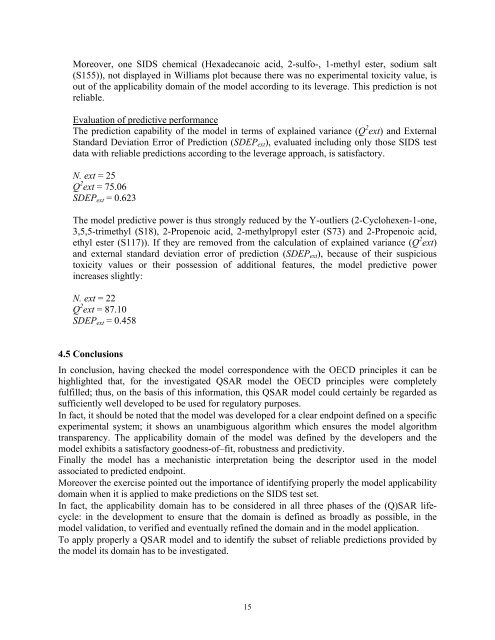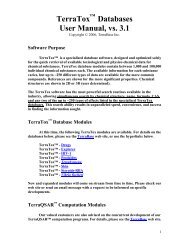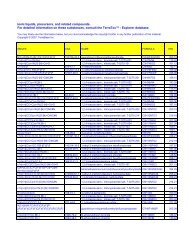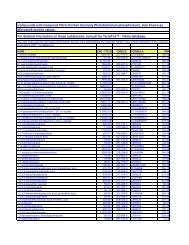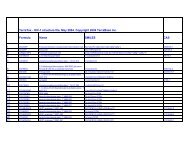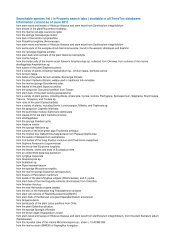Comparative Assessment of QSAR Models for Aquatic Toxicity
Comparative Assessment of QSAR Models for Aquatic Toxicity
Comparative Assessment of QSAR Models for Aquatic Toxicity
You also want an ePaper? Increase the reach of your titles
YUMPU automatically turns print PDFs into web optimized ePapers that Google loves.
Moreover, one SIDS chemical (Hexadecanoic acid, 2-sulfo-, 1-methyl ester, sodium salt(S155)), not displayed in Williams plot because there was no experimental toxicity value, isout <strong>of</strong> the applicability domain <strong>of</strong> the model according to its leverage. This prediction is notreliable.Evaluation <strong>of</strong> predictive per<strong>for</strong>manceThe prediction capability <strong>of</strong> the model in terms <strong>of</strong> explained variance (Q 2 ext) and ExternalStandard Deviation Error <strong>of</strong> Prediction (SDEP ext ), evaluated including only those SIDS testdata with reliable predictions according to the leverage approach, is satisfactory.N. ext = 25Q 2 ext = 75.06SDEP ext = 0.623The model predictive power is thus strongly reduced by the Y-outliers (2-Cyclohexen-1-one,3,5,5-trimethyl (S18), 2-Propenoic acid, 2-methylpropyl ester (S73) and 2-Propenoic acid,ethyl ester (S117)). If they are removed from the calculation <strong>of</strong> explained variance (Q 2 ext)and external standard deviation error <strong>of</strong> prediction (SDEP ext ), because <strong>of</strong> their suspicioustoxicity values or their possession <strong>of</strong> additional features, the model predictive powerincreases slightly:N. ext = 22Q 2 ext = 87.10SDEP ext = 0.4584.5 ConclusionsIn conclusion, having checked the model correspondence with the OECD principles it can behighlighted that, <strong>for</strong> the investigated <strong>QSAR</strong> model the OECD principles were completelyfulfilled; thus, on the basis <strong>of</strong> this in<strong>for</strong>mation, this <strong>QSAR</strong> model could certainly be regarded assufficiently well developed to be used <strong>for</strong> regulatory purposes.In fact, it should be noted that the model was developed <strong>for</strong> a clear endpoint defined on a specificexperimental system; it shows an unambiguous algorithm which ensures the model algorithmtransparency. The applicability domain <strong>of</strong> the model was defined by the developers and themodel exhibits a satisfactory goodness-<strong>of</strong>–fit, robustness and predictivity.Finally the model has a mechanistic interpretation being the descriptor used in the modelassociated to predicted endpoint.Moreover the exercise pointed out the importance <strong>of</strong> identifying properly the model applicabilitydomain when it is applied to make predictions on the SIDS test set.In fact, the applicability domain has to be considered in all three phases <strong>of</strong> the (Q)SAR lifecycle:in the development to ensure that the domain is defined as broadly as possible, in themodel validation, to verified and eventually refined the domain and in the model application.To apply properly a <strong>QSAR</strong> model and to identify the subset <strong>of</strong> reliable predictions provided bythe model its domain has to be investigated.15


